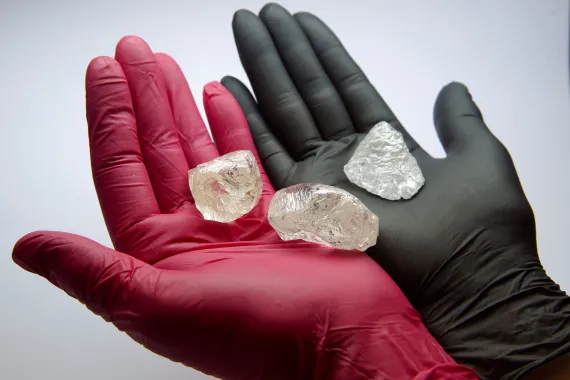Despite sanctions, EU keeps on doing business with Russia
With 10 rounds of sanctions, since Russia invaded Ukraine in February last year, the European Union has rolled out its toughest punishments ever against a foreign country.
The EU has said its sanctions are meant to cut Moscow’s revenues and access to technology used in war.
But the impact “will not be severe enough to limit Russia’s ability to wage war against Ukraine in 2023”, a European Parliament research note said.
Much trade still flows between the bloc’s 27 countries and Russia – a result of successful lobbying, the EU’s unwillingness to take a harder economic hit, and concerns about ripple effects on global supply chains.
Rather than seek new sanctions, the EU now wants to crack down on bypassing those already imposed, and officials identified the UAE, Turkey, Armenia, Georgia, Kazakhstan and Kyrgyzstan as potential circumvention routes.
Here is a list of areas where the EU keeps on doing business with Russia.
Trade flows
In 2021, Russia was the EU’s fifth-largest trading partner with goods exchange worth 258 billion euros ($280bn), according to the EU executive European Commission. The main EU imports were fuel, wood, iron and steel, and fertilizers.
Since the invasion in 2022, the value of EU imports from Russia fell by half to about 10 billion euros ($10.85bn) last December.
In total, the EU imported 171 billion euros ($186bn) worth of goods from Russia, starting from March 2022 until the end of January 2023, according to the latest data available from Eurostat, the EU statistics office.
That figure dwarfs the 60 billion euros ($65bn) the EU said last month that it had assigned to Ukraine over the year since the invasion, though that total does not include the value of modern tanks Kyiv was sent since or the latest deal on ammunition supplies.
LNG
The EU sanctioned imports of Russian coal and seaborne oil last year. Gas is not covered by EU sanctions, but Moscow slashed pipeline deliveries to Europe since the invasion. In 2022, the EU received about 40 percent less Russian gas than in recent years.
Liquefied natural gas is another story. Russian LNG deliveries to Europe increased since the war – to 22 billion cubic metres in 2022, up from approximately 16 bcm in 2021, according to EU analysis.
The LNG volumes are smaller than Russia’s pipeline gas deliveries, which were about 155 bcm per year before the war. But the uptick has led some countries to ask for a legal option under EU law to block LNG imports.
Nuclear
Similarly, there have been no sanctions against Russia’s nuclear industry, something Hungary – where Russian state nuclear energy company Rosatom is due to expand the Paks power plant – and Bulgaria have openly opposed.
EU imports of Russian nuclear industry products totalled nearly 750 million euros ($814bn) in 2022, according to Eurostat. EU nuclear agency Euratom said Russia provided a fifth of uranium used by EU utilities in 2021, the latest data available, as well as a fourth of conversion and a third of enrichment services.
The French energy ministry disputed parts of a report by Greenpeace, which last month said Paris had sharply increased imports of enriched uranium from Russia since the invasion. Paris said its contracts with Russia would be more expensive to halt than continue.
Diamonds
The EU bought 1.4 billion euros ($1.52) worth of Russian diamonds last year, according to Eurostat, as it banned neither the gem imports nor blacklisted Russian state-controlled miner Alrosa.
Belgium, home to the world’s biggest diamond trading hub Antwerp, has upset the bloc’s hawks by lobbying against the EU going solo on Russian diamonds.
The EU, the United States and other G7 economies are now working on a traceability system to squeeze out Russian diamonds together. The Antwerp World Diamond Centre said that needed to include India – not a G7 member – to be effective.
Chemicals and raw materials
EU imports of Russian fertilizers were worth 2.6 billion euros ($2.82bn) last year, more than 40 percent up from 2021 as price rise beat reduced volumes, according to Eurostat.
Potash from Russia and its ally Belarus is heavily restricted or banned in the EU. But other fertilizers including urea flow freely, said Sean Mackle of industry lobby Fertilizers Europe, adding that the patchy approach weighed on implementation.
Disagreement among the 27 EU countries about proposed exemptions to keep fertilizers going to Africa has blocked more sanctions against Belarus for aiding Russia’s war.
Among raw materials unaffected by sanctions is nickel, mostly used for stainless steel production. The EU imported 2.1 billion euros worth of nickel in 2021, up to 3.2 billion euros ($3.47bn) last year, according to Eurostat.
Big names and secondary sanctions
Alrosa and Rosatom are missing from the EU’s blacklist, which currently covers nearly 1,700 individuals and entities banned from the bloc. Gazprombank – the financial arm of Russia’s gas monopoly Gazprom GAZP.MM – and Russia’s privately owned, second-largest oil producer Lukoil are also missing.
Transparency International has long called for a cut in Russia’s access to EU lobbying and for secondary sanctions to punish those helping others already under sanctions, as is standard practice in the US



